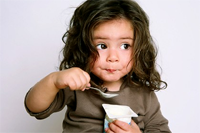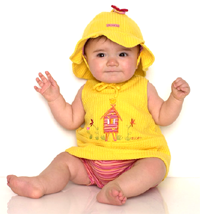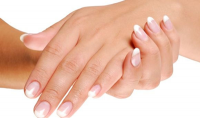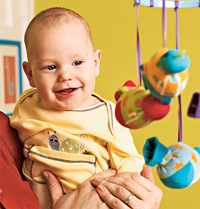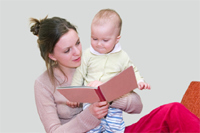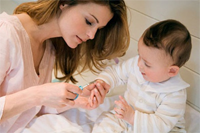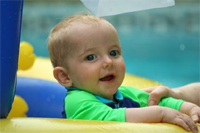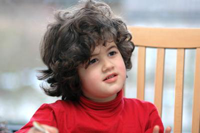New Born Baby Bathing Tips : 1. Parents must realise that newborn babies don’t need to be bathed daily. Washing newborns twice a week is more than sufficient. 2. It is essential to maintain a firm grip of newborn babies while washing them. 3. Based on his response to sensitivity with water, you can time babies’ bath. If he finds warm water soothing, let him linger in the water for a while. 4. Bath safety is another important aspect of newborn baby bathing. Therefore, ascertain that you are monitoring the baby for every single minute. 5. Essential bath supplies like water, towel, clean diaper and clothes should be kept around the washing area for easy access. 6. Ensure that water is not hot, which might affect sensitive skin of newborn. 7. Undressing baby should depend on his comfort. Leave the diaper on at first for baby’s comfort in the water. 8. During bath, pour water over newborn baby so that he doesn't pick up cold. 9. Use mild soap or baby shampoo with a washcloth from top to bottom, front and back. 10. Scalp should be washed with a wet, soapy cloth. However, ensure that no soap is used to clean eyes and face. 11. Towards the end, use a clean washcloth before drying the baby with towel. 12. Pat baby dry, wrapping him in a hooded towel. 13. Thereafter, apply a mild baby lotion, diaper baby and dress him up.
మీ పిల్లలు భయపడుతున్నారా? 1. ముందుగా వారి భయాన్ని అర్ధం చేసుకోండి: వారు జీవించే లోకాన్ని చిన్నపిల్లలు ఇప్పుడిప్పుడే తెలుసుకుంటున్నారు. వారి ఉహాశక్తి అభివృద్ధి చెందే దశలో ఉండడంవల్ల నిజ జీవితంలో చూసిన లేదా విన్న కొన్ని సంఘటనలు, భయంకరమైన రూపాలుగా మనసులో చిత్రింపబడుతాయి. ఆ విధంగా చీకటి అంటే భయం ఏర్పడడం, చీకటి గదిలో వివిధ రకాల ఆకారాలను ఉహించుకోవడం జరుగుతాయి. వేరు వేరు వయస్సులలో వివిధ విషయాలకు, వివిధ తీవ్రతలలో పిల్లలు భయపడతారు. కాబట్టి, భయాన్ని అధిగంచడానికి ప్రత్యేకంగా ఒక దారంటూ లేదు. పిల్లల ఒత్తిడిని తట్టుకునే శక్తి, పిల్లల ఎదుగుదలని దృష్టిలో పెట్టుకుని వారి భయాన్ని తొలగించే ప్రయత్నాన్ని ప్రారంభించాలి. 2. మీ పిల్లలతో మాట్లాడండి: మీ పిల్లలతో మాట్లాడడం ద్వారా వారి ని మీరు సౌకర్యంగా ఉంచగలరు. వారి భయాలని మీతో పంచుకునే స్వేచ్చనివ్వండి. మీ పిల్లలు ఏ విషయంలో ఎందుకు భయపడుతున్నారో అడగండి. ఆ సమయంలో వారి భావనలు తెలుసుకోండి. వారి భయాలను పంచుకునే సమయంలో మీరు శ్రద్దగా గమనించండి. చిన్నతనంలో మీరు కూడా కొన్ని సంఘటనలకు భయపడే వారని తెలియచేయండి. ఇలా చెయ్యడం వల్ల, మీరు వారి గురించి శ్రద్ధ తీసుకుంటున్నారని మీ పిల్లలకి అర్ధం అవుతుంది. 3. సరైన సందేశాన్ని అందించండి: "చిన్న పిల్లలా ప్రవర్తించవద్దు", "భయపడవద్దు", "మీ స్నేహితులు చూడు భయపడకుండా ఉంటారు" లాంటి వి చెప్పడం ద్వారా మీ పిల్లలకి తప్పుడు సందేశాన్ని పంపించవద్దు. దీని ద్వారా భయపడడం తప్పని అర్ధం చేసుకుని వారు మీతో వారి భయాలని పంచుకోవడానికి సంకోచించవచ్చు. భయపడడం సర్వ సాధారణమని భయానికున్న కారణాలు మీతో పంచుకుని తగిన సహాయం అడగవచ్చని వారికి తెలియచేయండి. 4. వారి భయాన్ని తేలికగా తీసుకోకండి: ఇంటి పక్కన ఉండే వాళ్ళు, సంరక్షకులు, లేదా మీ చుట్టాల్ల గురించి మీ పిల్లలు భయపడుతుంటే వారి భయాన్ని తేలికగా తీసుకోకండి. దాని బదులు, వారు ప్రత్యేకించి భయపడుతున్న వ్యక్తుల గురించి తెలుసుకోండి. ఎందుకు భయపడుతున్నారో అడగండి. ఒక వేళ ఆ వ్యక్తి వల్ల మీ పిల్లలకి ఎటువంటి హానీ లేకపోయినా, మీ పిల్లల భయాలని పరిగణలో కి తీసుకుని ఆ దిశగా చర్యలు తీసుకోండి. 5.మీ పిల్లల భయాలని ఎగతాళి చేయకండి: మీ పిల్లల భయాలని ఎగతాళి చెయ్యడం వారికి అసౌకర్యం కలిగించడమే కాకుండా, వారి ఆత్రుత శాతం పెరిగి ఆత్మగౌరవ లోపం కలిగే అవకాశాలు కలవు. మీరందించే ప్రేమ, శ్రద్ధల నుండి మీ పిల్లల భయాలని తొలగించవచ్చు అంతే కాని, వారి భయాలని నిర్లక్ష్యం చెయ్యడం ద్వారా వారిలో ని ప్రతీకూల ఆలోచనలు పెరుగుతాయి. 6. మీ పిల్లలను బలవంతపెట్టకండి: బలవంత పెట్టడం ద్వారా భయం మరింత పెరుగుతుంది. మీరే ఒక సారి ఆలోచించండి, మీకు బంగీ జంప్ అంటే భయం ఉన్నప్పుడు బంగీ జంప్ చేయమనడం లేదా మీరు భయపడే ఎదైనా భయానక కీటకాన్ని మిమ్మల్ని పట్టుకోమనడం మీకెలా అనిపిస్తుందో. మీ పిల్లలకి భయాలని అధిగమించుకునేందుకు కొంత సమయాన్ని కేటాయించండి. ప్రేమ, శ్రద్ధలు అందించడం ద్వారా వారికి సహకరించండి. 7.ధైర్యాన్ని కనపరచండి: మీ చర్యలనే మీ పిల్లలు అనుసరిస్తూ ఉంటారు. ఏదైనా సందర్భంలో మీరు అతిగా స్పందిస్తే, అలాంటి సందర్భాలలో మీ పిల్లలు కూడా అలాగే ప్రవర్తిస్తారు. ఏదైనా, లేదా ఎవరైనా మీకు సురక్షితంగా ఉంటే, మీ పిల్లలు వారికి కూడా సురక్షితమని నమ్ముతారు. ప్రతీ సారి మీ పిల్లల రక్షణ కోసం కొన్ని సందర్భాలలో భయపడేతత్వాన్ని మీ ద్వారా అలవాటు చేయకండి. మీ పిల్లలకి ఏదైనా సందర్భం లేదా విషయానికి సంబంధించిన వి ఏవి చెయ్యొచ్చు, ఏవి చెయ్యకూడదు అనేవి స్పష్టంగా తెలియచేయడం ద్వారా వారికీ సహాయపడింది. 8.భయానక పాత్రల నుండి మీ పిల్లలని దూరంగా ఉంచండి: పిల్లలు వాస్తవానికి, కాల్పనికతకి ఉన్న తేడా ని పసిగట్టలేరు. టీవీ లో కాల్పనికత పాత్రలని చూసి భయపడిపోతారు. భయానక టీవీ షోస్ ని మీ పిల్లలు చూడకుండా జాగ్రత్త తీసుకోండి. అలాగే, మీ పిల్లలకి వాస్తవికత మరియు కాల్పనికత ల మధ్య ఉన్న తేడా ని తెలియచేయడానికి ప్రయత్నించండి. టీవీ లో చూపెట్టే కార్టూన్స్ మరియు మూవీస్ ని ఎలా చిత్రీకరిస్తారో సులభంగా వారికి తెలియచేయండి. 9.ఇల్లంతా మీ పిల్లలతో కలిసి తిరగండి: దీని ద్వారా కొన్ని గదులు, ప్రదేశాలు వంటి వి ఏవైతే మీ పిల్లల భయానికి కారణమో ఆ ప్రదేశాలు వారికి అలవాటు అవుతాయి. ఇంట్లో ఉన్న అన్ని తలుపులూ తీసి, మంచం కింద మరియు వెలుగు చేరని చోట లైట్ వెలిగించి అక్కడేమి లేదని వారికి తెలియచేయండి. ఒక వేళ మీ పిల్లలు ఏవైనా భయంకర శబ్దాలు లేదా నీడ లోని ఆకారాలని చూసి భయపడుతూ ఉంటే ఆ సమస్యని మీ పిల్లలతో చర్చించండి. వేటి ద్వారా ఈ శబ్దాలు రావచ్చో చర్చించండి.
వయసు పెరిగేకొద్దీ జ్ఞాపకశక్తి తగ్గుతుంటుంది. దీనితో పలు ఇబ్బందులు ఏర్పడుతుంటాయి. సాధారణంగా పిల్లలు చదివిన విషయాలను గుర్తుంచుకుంటారేమో గానీ, అదే పరీక్ష సమయంలో చదివిన విషయాలను మరచిపోతుంటారు. పరీక్షలొస్తున్నాయంటే చాలు పిల్లలు మానసిక ఆందోళనకు, ఒత్తిడికి గురవుతుంటారు. వాళ్ళు మామూలు సమయాల్లో ఎంత బాగా చదివినా, ఆందోళన వల్ల, భయం వల్ల పరీక్షల్లో తగిన ఫలితాన్ని సాధించలేకపోతారు. ఇలాంటి పిల్లల కోసం తల్లిదండ్రులు కొన్ని జాగ్రత్తలు తీసుకోవాలి. అవి ఏమిటే చూద్దామా....! 1. పరీక్షలు సమీపిస్తున్నాయంటే పిల్లల్లో ఒక విధమైన భయానికి లోనవుతుంటారు. అలాంటి వారికి పోషకాలు గల ఆహారం వారి తల్లిదండ్రులు తప్పక ఇవ్వాలి. 2. పిల్లలకు మంచి ఆహారంతోపాటు విటమిన్ బి12, విటమిన్బి6, విటమిన్ సి, ఇ, క్యాల్షియం, మెగ్నీషియం, పొటాషియం ఉన్న ఆహారాన్ని ఇవ్వాలి. 3. పరీక్షల సమయంలో కొవ్వు పదార్థాలను వీలైనంతవరకు తగ్గించడం చాలా మంచిది. ఎక్కువ ఫ్యాట్ ఉండే పదార్థాలను తీసుకోవడం వల్ల చురుకుదనం లోపిస్తుంది. 4. నేరేడు పండులో జ్ఞాపకశక్తిని పెంచే యాంటీ యాక్సిడెంట్లు ఎక్కువగా వుంటాయి. ద్రాక్ష, చెర్రీస్లో యాంటీ ఆక్సిడెంట్స్ అధికంగా ఉండడం వల్ల రోజూ ఒక గ్లాస్ ద్రాక్ష జ్యూస్ తీసుకోవడం ఎంతో మంచిది. 5. అలాగే ఆపిల్స్లో కూడా విటమిన్లతోపాటు కాల్షియం, క్వెర్సిటిన్, ఆంథోసియానిన్ అనే యాంటీ ఆక్సిడెంట్లు ఉండటం వల్ల మతిమరుపు సమస్యను తప్పించుకోవచ్చు. 6. ఇక పాలకూర వాడకం కూడా జ్ఞాపకశక్తిని పెంపొందిస్తుంది. బొప్పాయి, అరటిపండులో ఉన్న పోలేట్, మెగ్నీషియం, పోటాషియం, విటమిన్ బి6 మెదడును ఆరోగ్యంగా ఉంచుతాయి. ఈ పండ్లలోని పిండిపదార్థం మెదడును ఎక్కువసేపు చురుకుగా ఉండేటట్లు చేస్తాయి. 7. తేనె వాడకం వల్ల యాంగ్జైటీ తగ్గి జ్ఞాపకశక్తి వృద్ది చెందుతుంది. పిల్లల్లో జ్ఞాపకశక్తి పెంపొందాలంటే, వారు పరీక్షల్లో మంచి మార్కులు సాధించాలంటే వారికి పోషకాహారం తప్పక అందించాలి.
Holding a baby is good Holding your baby closer gives them comfort. They feel warm and lovable. They usually cry, thinking that nobody is around. When the time they cry, hold them closer. Don't use baby wipes Baby wipes are expensive and, for some sensitive bums, they can hurt. Usually people will not believe this, but a 100 percent breastfed baby doesn't need baby wipes. Not at all. Breastfed baby feces are low in acid and bacteria, watery and wipe off easily. Avoid excess soap use Instead of soap you can sometimes use a mixture of gram flour (senaga pindi) and milk to bathe the baby. To massage the baby you could use a mixture of gram flour and cream with a pinch of turmeric. Apply the mixture on the baby's body and gently rub it off. No water or glucose for new born A newborn should not be given any prelactal feed, be it honey, water or glucose water. The baby doesn't need anything at that time apart from the colostrum.
పిల్లలు ఊరుకోరంటూ చిన్నప్పుడు మనమే వారు అడిగినదల్లా వెంట వెంటనే కొనిస్తుంటాం. పిల్లలు ఇలాంటి వాటికి అలవాటు పడకుండా ఉండాలంటే ఏం చేయాలో, ఏం చేయకూడదో ఇపుడు తెలుసుకుందాం. పిల్లలు ఏదైనా కొనివ్వమని మారం చేసినపుడు వెంటనే కొనివ్వకూడదు. ముందుగా వారికి వద్దని సర్దిచెప్పే ప్రయత్నం చెయ్యాలి. ఇలా కూడా వినకపోతే వారికి ఏదైనా పని చెప్పి, అది పూర్తి చేస్తేనే కొనిస్తాను అనే మాట ఇవ్వాలి. వాళ్ళు ఆ వస్తువు కోసం కచ్చితంగా ఆ పని చేసి తీరుతారు. లేదా అలా అడగడం మానేస్తారు. ఒకవేళ ఆ పని గనుక మొత్తం పూర్తి చేస్తే మీరు కచ్చితంగా ఆ వస్తువును కొనివ్వాలి. అదే విధంగా చదువు విషయంలో కూడా ఇలాగే చేయాలి. ఏదైనా కోరుకుంటే.... ముందుగా పరీక్షల్లో ఫస్ట్ క్లాస్ లో పాస్ అయితే ఇస్తానని మాటివ్వాలి. ఒకవేళ పాసైతే ఆ వస్తువును కొనివ్వాల్సిందే. ఇలా చేయడం వల్ల మీ పిల్లల్లో ఒక ఆత్మవిశ్వాసం, పట్టుదల పెరిగి ఎలాంటి సమస్యలనైన ఎదుర్కునే మంచి పౌరులుగా తయారవుతారు. మరి మీకు ఇంతకంటే కావాల్సింది ఏముంది చెప్పండి.
ఓర్పుకు పరీక్షపెట్టే కొన్ని రకాల కార్యకలాపాలలో పిల్లలు పాల్గొనేటట్లు చూస్తే, అన్నీ విషయాలలోనూ తొందరపడకుండా ఓర్పుగా వుండటం పిల్లలు అలవాటు చేసుకుంటారు. ఓర్పుకు పరీక్షపెట్టి వేచి ఉండే సమయంలో వాళ్ళకి లోకం గురించే తెలియజేసే హాబీలలో పిల్లలను ప్రవేశపెట్టాలి. అప్పుడు వారిలో ఓర్పు, నేర్పులు త్వరగా అలవడుతాయి. ఉదాహరణకు... ఫజిల్స్ పూర్తి చేయటం, స్టాంపులు, నాణేలు సేకరించటం వంటి హాబీలను పిల్లలకు అలవాటు చేస్తే ... వారిలో నేమ్మదిగానైనా సహనం అలవడుతుంది. ఈ హాబీలలో వెంట వెంటనే రిజల్టు కనిపించదు కాబట్టి, వాటికోసం ఎదురుచూస్తారు. ఇది పిల్లలపై ఎంతో మంచి ప్రభావాన్ని చూపుతుంది. అదే విధంగా వారి ఆలోచన పరిజ్ఞానం కూడా మెరుగుపడుతుంది.
అమెరికన్ బళ్ళల్లో బెదిరింపుకి (బుల్లియింగ్) గురిఅవుతున్న విద్యార్ధులు అదొక స్కూల్ ఆవరణ. స్కూల్ పిల్లలంతా ఆడిటోరియంలో కూర్చుని ఆ రోజు బుల్లియింగ్ (Bullying) గురించి మాట్లాడటానికి వచ్చే గెస్ట్ కోసం ఎదురు చూస్తున్నారు కబుర్లు చెప్పుకుంటూ. రాబర్ట్, 45 ఏళ్ళ వయసు వుంటుంది. స్టేజ్ పైకి వచ్చి తనను తాను పరిచయం చేసుకున్నాడు. ఆ తర్వాత స్క్రీన్ పైకి కంప్యూటర్ వాడుతూ ఒక అబ్బాయి, పదమూడేళ్ళ వయసుంటుంది, నీలి కళ్ళతో, వొత్తైన జుట్టుతో, బుగ్గల్లో సొట్టలతో నవ్వుతూ వున్న ఫోటో ప్రొజెక్ట్ చేసాడు. పిల్ల్లలందరూ ఇంకా మాట్లాడుకుంటున్నవారు ఆ ఫోటో చూడగానే నిశ్శబ్దంగా అయిపోయారు. ఆ ఫోటో చుట్టూ ఆ అబ్బాయి చిన్నప్పటి, ఫోటోలు పెట్టాడు రాబర్ట్. ఆ తర్వాత గొంతు సవరించుకుని మాట్లాడసాగాడు. రాబర్ట్ చిన్న కొడుకయిన స్టీవ్ ఎలా బుల్లియింగ్ గురి అయ్యాడు చెప్పసాగాడు. స్టీవ్ పుట్టినపుడు మామూలుగానే అనిపించాడు, చూడడానికి అందరిలా మామూలుగా పెరుగుతున్నాడు, ముద్దులు మూటకడ్తూ అందరినీ ఆనందంలో ముంచేస్తున్నాడు. కానీ స్కూల్ వయసు వచ్చేసరికి తెలిసిందేమంటే అతనికి ఏ.డి.హెచ్.డి (ADHD-Attention Deficit Hyperactivity Disorder) వుందని తేలింది. అది తెలిసిన తర్వాత ఇంట్లోనే తల్లి తండ్రి హోం స్కూలింగ్ అని స్కూల్ నుండి సిలబస్ తెప్పించి చదువు చెప్పారు. అలా కొన్నాళ్ళయ్యాక స్పెషల్ ఎడ్, అంటే ఇలాంటి పిల్లలకి వారికి చెప్పాల్సిన పద్దతిలో అన్నీ నేర్పిస్తారు, అక్కడికి వెళ్ళేవాడు. కొన్నేళ్ళ తర్వాత ఆ టీచర్లు స్టీవ్ బాగా ఇంప్రూవ్ అయ్యాడని ఇక అతన్ని మామూలు స్కూలుకి పంపించవచ్చని చెప్పారు, దాంతో స్టీవ్ మామూలు స్కూలుకి వెళ్ళసాగాడు. కొన్నాళ్ళు బాగానే గడిచింది కానీ అతని సంగతి తెలిసిన వారు అతన్ని తెలివిలేని దద్దమ్మలా చూడడం, నానా రకాల మాటలతో, చేతలతో బెదిరించడం, విసిగించడం మొదలు పెట్టారు. ఇంట్లో వారికి తెలిసింది. మొదలు స్టీవ్ కి అవన్నీ పట్టించుకోవద్దనీ, వాళ్ళు అన్నంత మాత్రానా, స్టీవ్ వ్యక్తిత్వం మారిపోదని, ధైర్యం చెప్పారు. తనతో క్లోజ్ గా తిరిగే ప్రెండ్ తో సరదాగా ఏదో జోక్ చెబితే అతను వెళ్ళి స్టీవ్ కి ఆడపిల్లలంటే ఇష్టం లేదని అతను "గే" అని అందరికి చెప్పాడు. దాంతో స్టీవ్ పరిస్థితి మరింత కఠినమై పోయింది. సెలవుల్లో ఆన్ లైన్ లో తన ఫ్రెండ్స్ లిస్ట్ లో ఒకమ్మాయిని తన గర్ల్ ఫ్రెండ్ గా పెట్టుకున్నాడు. ఆ అమ్మాయి కూడా అతనంటే తనకిష్టం అని ఆన్ లైన్ లో చెప్పేది. స్కూల్ తెరవగానే ఆ అమ్మాయి వచ్చి అందరి ముందర స్టీవ్ అంటే తనకిష్టం లేదని, అతనొక స్టుపిడ్ అని, అతన్ని తను ఎలా ఇష్టపడుతుంది అని పగలబడి నవ్వి తామిద్దరూ ఆన్ లైన్ లో రాసుకున్న మెసెజస్ అందరికీ చదివి వినిపించింది. అది విని అందరూ పడి పడి నవ్వసాగారు. స్టీవ్ నివ్వెరపోయాడు. అతని వయసు 13, ఇంత అవమానాన్ని అతని మనసు తట్టుకోలేక పోయింది. అది స్టీవ్ జీవితంలో మొదటి ప్రేమ, తను ప్రేమిస్తున్న అమ్మాయి అంత భయంకరంగా అవమానించడం ఆ చిన్ని మనసు తట్టుకోలేకపోయింది. ఇంటికి వచ్చి ఆత్మహత్య చేసుకున్నాడు. రాబర్ట్ కి ముందు కోపం వచ్చినా దానివల్ల తను ఏమీ చేయలేనని, స్టీవ్ తిరిగి రాడని అందుకే తన కొడుక్కి జరిగిన అన్యాయం మళ్ళీ ఎవరికీ జరగకుండా వుండాలని, బుల్లియింగ్ గురించి చాలా రిసెర్చ్ చేసి అమెరికాలో ఎన్ని స్కూల్స్ వీలయితే అన్ని స్కుల్స్ కెళ్ళి ఈ బుల్లియింగ్ గురించి అవగాహన పెంచాలని నిశ్చయించుకున్నాడు. ఎంతో భవిష్యత్తు వున్న ఇంకా ఎన్నో నేర్చుకోవాల్సిన వయసులో అర్ధాంతరంగా ఏ జబ్బు లేకుండా, ఆడుతూ పాడుతూ వున్న పిల్లలు జీవితాన్ని ప్రేమించాల్సినవారు అంత చిన్న వయసులో ఎలా ప్రాణాలు తీసుకుంటున్నారో తెలియక జుట్లు పీక్కుంటున్నారు తల్లి తండ్రులు. తాము ఏం తప్పు చేసాము, ఇంకా ఏమన్నా చేయాల్సిందా అని కుమిలిపోతారు. అసలు బుల్లియింగ్ అంటే ఏమిటీ అన్నది మీకందరికీ ఈ సంఘటన చదివితే ఒక ఐడియా వచ్చి వుంటుంది. స్కూల్స్ అంటే చదువుకోవడానికి, స్నేహితులతో సరదాగా గడపడానికి, ఆటలాడుకోవడానికి, భవిష్యత్తుకి మార్గం వేసుకోవడంలా వుండాలి. కానీ అమెరికాలో, యూరోప్ లో కొన్ని స్కూల్స్ లో ఈ బుల్లియింగ్ ఎంతో మంది చిన్నారుల ప్రాణాలు తీసుకోవడానికి కారణం అవుతుంది. ఇది ఎలిమెంటరీ స్కూల్ లో మొదలైతే, మిడిల్ స్కూల్ లో, హైస్కూల్ వరకూ కొనసాగుతుంది. ఒకో స్టేజ్ లో ఒకో రకంగా వుంటుందీ బుల్లియింగ్. ఈ బుల్లియింగ్ మిడిల్ స్కూల్ లో ఎక్కువగా జరుగుతుందని ముఖ్యంగా ఐదు, ఆరవ తరగతి వారిని ఏడు, ఎనిమిది తరగతి వారు ఏడిపిస్తుంటారని ఒక సర్వేలో తేలింది. బుల్లియింగ్ చేసేవారు కొట్టడం, తన్నడం, తోసెయ్యడం, క్రింద పడేయడం, స్కూల్ బస్ లో నానా రకాలుగా విసిగించడం చేస్తుంటారు. ఈ బుల్లియింగ్ ఎన్నో రకాలుగా వుంటుంది. పెద్ద చేప చిన్న చేపని తిన్నట్టుగా స్కూల్స్ లో అదే విధంగా కొంచెం బాగా మాట్లాడగలిగేవారు, ఒకోసారి కొంచెం డబ్బున్న వారు లేదా బాగా కంట్రోలింగ్ వ్యక్తిత్వం వున్నవారు తమచుట్టూ ఒక గ్రూప్ ని తయారు చేసుకుంటారు. వీరిని పాపులర్ కిడ్స్ అంటారు, వీరిలో మగపిల్లలయితే చదువులో మంచి గ్రేడ్స్ వచ్చినా రాకున్నా, కొంచెం సింపుల్ గా వుండి, కొద్దిగా సిగ్గుపడుతూ, మరీ ఎక్కువగా మాట్లాడడం రాని వారిని శారీరకంగా బలహీనంగా వున్నా, వికలాంగులను, వేరే దేశస్థులను, వేరే జాతికి చెందిన వారిని, నల్లవారిని, లేదా తల్లి తండ్రుల్లో ఒకరు తెలుపు, ఒకరు వేరే దేశస్థులయినా, లేదా, ఇతర జాతికి సంబంధించిన వారైనా, ఏమైనా చిన్న లర్నింగ్ ప్రాబ్లెమ్స్ వున్నా, ఇలా ఒక విషయం అని చెప్పడానికి లేదు వారికి పిల్లలను బెదిరించడానికి, తమ బలాన్ని చాటుకోవడానికి ఏదో ఒక కారణం కావాలి అంతే. సున్నిత మనస్కులయిన పిల్లలయితే ఈ బుల్లియింగ్ ని తట్టుకోలేక ప్రాణాలను కూడా తీసుకుంటారు. దీన్న”బుల్లిసైడ్’ అంటున్నారు. గ్రూప్ గా ఏడిపించడం ఒక రకమైతే, ఒక్కరే ఒకరిని పట్టుకుని కొట్టడం, వారి తలని గోడకేసి కొట్టడం, కాళ్ళతో తన్నడం, జుట్టు పట్టి పీకడం, గొంతు పిసకడం,వారి వస్తువులు పాడుచేయడం, పడేయడం చేస్తారు. మిడిల్ స్కూల్ లో పాపులర్ అమ్మాయిలు, పాపులర్ కానీ అమ్మాయిలని వుంటారు. పాపులర్ అమ్మాయిల్లో కొంచెం అందంగా వుండి బాగా ఫ్యాషనబుల్ బట్టలు వేసుకుని, బాగా చదువుకుంటూ సింపుల్ గా వుండే అమ్మాయిలను, కళ్ళకు కాంటాక్ట్స్ కాకుండా కళ్ళద్దాలు పెట్టుకునే అమ్మాయిలను, టీజ్ చేయడం, అమ్మాయిల్లో ఎక్కువగా తాము బెదిరించే అమ్మాయిల గురించి పుకార్లు పుట్టించి వాటిని అందరికీ ప్రచారం చేయడం, వారికి సంబందించిన వస్తువులను దాచేయడం లేదా దొంగిలించడం, వారిని మాటలతో, తిట్లతో ఇన్ సల్ట్ చేయడం చేస్తుంటారు. స్పోర్ట్స్ ఆడేవారు, ఆడనివారిని చులకనగా చూడడం, అమ్మాయిల్లో, చియర్ లీడింగ్ చేసేవారు తాము చాలా అందంగా వుంటామని, వారంతా ఒక గ్రూప్ గా వుంటారు వేరే వారిని తమతో ఎక్కువగా కలవనీయరు. మిగతా అమ్మాయిలను చులకనగా చూస్తారు. (అందరూ ఇలాగే వుంటారని కాదు కానీ చాలావరకు ఇలాగే వుంటున్నారని సర్వేలు తెలుపుతున్నాయి.) ఆన్ లైన్ ద్వారా బుల్లియింగ్ ని సైబర్ బుల్లియింగ్ అంటున్నారు. హై స్కూల్లో ఎక్కువగా జరుగుతుంటుంది, ఈ మధ్యన మిడిల్ స్కూల్ కి కూడా పాకింది అంటున్నారు ఈ బుల్లియింగ్ పై సర్వే చేసినవారు. ఈ సైబర్ బుల్లియింగ్ లో ఎవరైన ఒకరి గురించి ఉన్నవీ లేనివీ కల్పించి రాసి అందరికీ మెసేజస్ ద్వారా పంపించి వారి ఆత్మవిశ్వాసం, ఆత్మ స్థయిర్యం పై దెబ్బ తీయడానికి ప్రయత్నం చేస్తారు. స్కూల్లో ఫ్రెండ్స్ లేనివారు ఈ ఆన్ లైన్ ఫ్రెండ్ షిప్ చేయడం మోసం గురించి తెలియనివారిని ఫ్రెండ్స్ అయ్యి వారి నమ్మకాన్ని సంపాదించుకున్న తర్వాత వారు చేయమన్న పనులను చేసేట్టు చేసుకుంటారు. ఇందులో అందమైన అమ్మాయిలనయితే చిన్న బట్టలేసుకుని డ్యాన్స్ చేయమని అడగడం, అదీ సరదా కోసం అని నమ్మిస్తూ, ఆ తర్వాత వారికిష్టమయిన రీతిలో వారి ఫోటోలు తీసుకోవడం, లేదా ఫిల్మ్ చేయడం వాటిని ఏమి చేయము అని చెప్పి ఆన్ లైన్ లో పోర్నోగ్రఫి సైట్స్ అన్నిట్లో పోస్ట్ చేయడం అవి స్కూల్లో వారు చూసి ఆ అమ్మాయిని ఏడిపించడం చేస్తారు. అది తట్టుకోలేక ఆత్మహత్యలు చేసుకుంటారు. 2010 లెక్కల ప్రకారం ప్రతి ఏడాది 2.7 మిలియన్ల విద్యార్ధులు ఈ బుల్లియింగ్ కి గురవుతున్నారు. కిండర్ గార్టెన్ నుండి పన్నెండవ తరగతి వరకు ఏడుగురు విద్యార్ధుల్లో ఒకరు ఒక బుల్లిగానో లేదా బుల్లియింగ్ కి గురయినవారున్నారు. ఒకోసారి ఒక టీనేజర్ కానీ చిన్నపిల్లలు కానీ బుల్లియింగ్ కి గురయితే వారే మళ్ళీ బుల్లియింగ్ చేసే అవకాశం వుంది ఎందుకంటే వారికి ఎవరిపైనైన కక్ష తీర్చుకోవాలనిపించడమే కారణం. అసలు ఈ బుల్లియింగ్ ఎందుకు చేస్తారు? అన్న ప్రశ్నకి సైకాలజిస్ట్ లు ఇచ్చే సమాధానం, " ఎవరైనా సరే, ఈ బుల్లియింగ్ చేసేవారు టీనేజర్స్ కానీ, చిన్నపిల్లలు కానీ, పెద్దవారు కానీ వారు ఇంట్లో వారి చేతిలో హింసాత్మక చర్యలకు గురైతే వారే ఇలా ప్రవర్తించే అవకాశం ఎక్కువగా వుంది," అంటున్నారు. దేశం మొత్తంలో ప్రతి నెల దాదాపు 282,000 విద్యార్ధులు బుల్లియింగ్ కి గురవుతున్నారని ఈ లెక్కల ప్రకారం తెలుస్తుంది. యేల్ స్కూల్ ఆఫ్ మెడిసెన్ (Yale School of Medicine) కొత్త స్టడీ ప్రకారం యవ్వనంలోకి అడుగిడుతున్న వారి ఆత్మహత్యలు గత ముప్పై ఏళ్ళకన్నా50% కంటే ఎక్కువగా పెరిగిపోయాయి. బుల్లియింగ్ కి గురయ్యేవారు డిప్రెషన్ కి లోనవ్వుతారని, దాన్ని గమనించి స్కూల్లో కౌన్సిలర్ దగ్గర కానీ, థెరఫిస్ట్ దగ్గరకు తీసుకెళితే వారు ఈ సమస్యను ఎదుర్కునే ధైర్యం వస్తుంది, ఆత్మహత్యయ్ చేసుకోకుండా ఆపవచ్చు కూడా. పిల్లలు బుల్లియింగ్ కి గురవ్వకుండా వుండాలంటే తల్లితండ్రులు పిల్లలతో దాని గురించి మాట్లాడాలని, స్కూల్లో ఎవరన్నా విసిగిస్తుంటే తల్లి తండ్రులకు చెప్పొచ్చు అనే ధైర్యం వస్తుంది. పిల్లల్లో ముందునుండే ఆత్మస్థయిర్యం, ఆత్మవిశ్వాసం పెంపొందేలా చూడాలని, దాని వల్ల ఎవరైనా విసిగించినా పిల్లలు పెద్దగా పట్టించుకోరని, బుల్లియింగ్ గురించి పిల్లలు వెంటనే పెద్దవారికి చెప్పడమో లేదా స్కూల్లో టీచర్స్ కానీ ప్రిన్సిపాల్ లాంటి వారికి రిపోర్ట్ చేస్తే అది తెలిస్తే విసిగించేవారు వెనక్కి తగ్గుతారు ఎందుకంటే వారికి కఠినమైన శిక్షలున్నాయి పిల్లల డిటెన్షన్ సెంటర్లలో. ఇప్పుడు దేశ వ్యప్తంగా స్కూల్స్ లో ఈ బుల్లియింగ్ కి వ్యతిరేకంగా ఎన్నో కార్యక్రమాలు మొదలుపెట్టారు, పిల్లల్లో, తల్లితండ్రుల్లో అవగాహన పెంచడం, పిల్లలు తమను తాము స్వయంగా రక్షించుకోవడానికి మార్షల్ ఆర్ట్స్ నేర్పించడం చేస్తున్నారు, బుల్లియింగ్ కి వ్యతిరేకంగా పుస్తకాలు రాస్తున్నారు, డాక్యుమెంటరీలు చేస్తున్నారు, రేడియోలో, టీ.వి.లో యాడ్స్ లా చూపిస్తుంటారు. పిల్లలు ఎప్పుడు ఒక్కరే వుండకుండా మంచి స్నేహితులతో ఎల్లప్పుడూ వుండాలని ఒకరికొకరు సాయం చేసుకుంటే కూడా ఈ బుల్లియింగ్ ని ఆపవచ్చని అంటున్నారు. -కనకదుర్గ
ఈ మధ్య విస్ కౌన్సిల్ వర్శిటీ పరిశోధకులు ఓ అధ్యయనం నిర్వహించారట.. అందులో "అమ్మ" పవర్ ఎంతో మరోసారి తేలిందట. అదేనండి మనకి ఏ మాత్రం బాధ కలిగినా మొట్టమొదట నోట్లోంచి వచ్చే మాట "అమ్మ" అనే కదా! నిజానికి అసంకల్పితంగా మనమా మాట అన్నా కూడా ఆ పదానికి ఉన్న పవర్ మనల్ని ఊరట పరుస్తుందట. మనసుకి బాధ కలిగిన క్షణంలో "అమ్మ" అంటూ అమ్మతో అన్ని చెప్పుకున్నట్టు మనసులో చెప్పినా, అమ్మ ఫోటో చూసినా ఎంతో మానసిక స్వాంతన కలుగుతుండటం గమనించారట పరిశోధకులు. "అమ్మ"తో కలిసి ఉండే పిల్లలు మానసికంగా ధైర్యవంతులుగా ఉంటారని అంటున్నారు పరిశోధకులు. ముఖ్యంగా ఒత్తిడి, ఆందోలనలలో వున్నప్పుడు అమ్మ దగ్గర ఓ పాడి నిముషాలు కూచుంటే చాలట. అది వీలు కాకపోతే ఫోన్ లో అమ్మ గొంతు విన్నా ఒత్తిడి, ఆందోళనల స్థాయి తగ్గటం గుర్తించారు పరిశోధకులు. 80% యూత్ పిల్లల విషయంలో "అమ్మ" ఔషధంగా ఉపయోగపడుతుందంటున్నారు. కాబట్టి ఎప్పుడూ, ఏ మాత్రం ఒత్తిడిగా అనిపించినా అమ్మ, అమ్మ ఫోటో, లేదా అమ్మ గొంతు మనకి వరంగా ఉపయోగపడుతున్నాయన్నమాట. -రమ
1)Have family meals: This is effective to increase your child's interest in food as they will be more excited to have food together with all their loved ones. Serve only healthy food to your family and encourage your toddler to follow the same. 2)Follow a timetable: Even though it is difficult to follow a strict timetable for feeding a toddler in the beginning, it is much recommended doing so. This will help them to take food when they feel hungry and promote a good digestion pattern. 3)Let your child choose: Instead of forcing them to eat whatever we give, give them a chance to select their favourites sometimes. This will keep them interested in food and allow you to know their choice. Try to give other nutritious food of almost the same appearance and taste. 4)Give healthy balanced diet: Avoid all unhealthy food items that are difficult to digest. Do not encourage your children to go for fat-filled, fried, sugary or other junk foods. Include more vegetables and fruits in their diets. 5)Re-introduce food: Just because your toddler refused a particular food doesn't mean that he/she will not like it next time also. Re-introduce the same food after a short time and sometimes that might be their favourite. 6)Encourage homemade food: This is very important than it seems to be. Do not offer a junk food during an outing as a reward because they will be directed to think that it is better than homely food. Hugs and kisses are more valuable and also calorie-free. 7)Leave them independent: As your child became a toddler now, allow and ask them to eat by themselves. Give food in colorful un-breakable plates and let them enjoy their food. But remember to supervise them to avoid any choking. 8)Try varieties: Instead of forcing your toddler to eat a food of your choice, try other varieties. Add colorful food items in their menu. Another idea is to mix-up foods. Mix nutritious food with their favorite ones. It is a difficult, but surely an important task to teach your toddler to develop a healthy relationship with food. Try these tips and direct your toddler to a healthy future.
Fever : Most kids suffer from fever very often. Now this disease in children might be due to cold, infection, or the development of a number of bugs inside the body. Many parents neglect it and try to go for home remedies in spite of the fact that such diseases might be infectious. But this might prove dangerous and it is better that you immediately call in a paediatrician if they have a fever 100 and above. Cold : Along with the baby diapers you will always find a medicine for cough in a house where there are children. This is one of the most common diseases that a child suffers from. In most of the cases it is a kind of viral infection that is accompanied by a running nose and sometimes fever. But coughs of a severe nature along with a high fever might also be an indication of influenza or pneumonia. It may also be a slight indication of your child being asthmatic. They do not fall in the list of highly infectious diseases and there is nothing much to be worried about it. Rashes : You cannot always take rashes to be the result of diapers. It might also be an allergy or skin problem. Though not infectious this one of the diseases this is found most commonly among children. Stomach Problems : Stomach problems like an upset stomach, constipation, acidity, indigestion etc, are some of the common diseases for a child. Most of these are due to the fact that they are used to eating a lot of things. Children also have a tendency to put anything in their mouth. This leads to infections and hence all the stomach problems. And moreover, if you find such symptoms along with a slight fever then immediately go for a medical consultation. Diarrhoea : This happens to be one of the most common diseases that a child suffers from. This can be due to the allergy to certain foods, food intolerance, indigestion or any kind of infection. You have to take certain preventive measures in this case. Keep giving your baby dosage of sugar and salt water to keep them hydrated. But if there is no improvement then you must visit a doctor immediately.
మృదువైన చేతులకోసం * ఉల్లిపాయలు కట్ చేసినపుడు ఘాటైన పదార్దాలను ఆ వాసనా చేతినుండి పోవాలంటే నిమ్మరసంతో చేతులు మర్దనా చేసి శుభ్రం చేసుకోవాలి. * నాలుగు చెంచాల నిమ్మరసంలో రెండు చెంచాల ఆలివ్ ఆయిల్ వేసి రాత్రి పడుకునే ముందు రాసుకుని పడుకుని మర్నాడు శుభ్రం చేసుకుంటే చేతులు మృదువుగా వుంటాయి. * టమాటా రసం రెండు చెంచాలు, నిమ్మరసం, గ్లిజరిన్ కలిపి రాసుకుని పావు గంట తరవాత కడిగేయాలి . ఇది మంచి బ్లీచింగ్ లా పనిచేస్తుంది. * పాల మీగడ, గ్లిజరిన్ ,నిమ్మరసం,చిటికెడు పసుపు కలిపి చేతులకు రాసి అరగంట తరువాత శుభ్రం చేసుకోవాలి. * ఘాటైన డిటర్జెంట్ చర్మానికి హాని కలిగిస్తుంది. అలాంటప్పుడు,బంగాలదుంపలు ఉడకపెట్టిన నీళ్ళల్లో ఒక 15 నిముషాలు చేతులు పెట్టాలి.అప్పుడు చేతులు మృదువుగా తయారైతాయి. * ఉడికించిన బంగాళాదుంపలను చేతుల మీద రుద్దితే చేతులకున్న మురికి పోయి శుభ్రపడతాయి. * బట్టలు ఉతికినప్పుడు చేతులు బరకగా తయారైతాయి . అలాంటప్పుడు కొబ్బరి నూనే కానీ మాయిశ్యరైజర్ కానీ తప్పకుండ రాయాలి. * అలాగే బాదాం ఆయిల్ కూడా చర్మానికి చాలా మంచిది.ఈ ఆయిల్ పడుకోబోయే ముందు చేతులకు రాసుకుంటే చాల మృదువుగా తయారైతాయి.
-If the end of the cello tape is lost, keep it in the freezer. After few minutes take it out and you will easily be able to find the end. -A handy colour palette can be made from an old ice tray. -A little vinegar added to hardened gum makes it spread evenly. -Always remember to close lids of varnish and enamel tins tightly. -In the long run small tins of varnish or enamel paints are more economical than bigger packaging. -If the cap of gum bottle has become tight and cannot be removed, immerse it in a little glycerin to open it. -To ensure that the chalk doesn't rub off the slate, just spray it with some hair spray. -Chalk dipped in milk and used on brown paper gives a fantastic sheen. -When using the cutting blade make sure you have kept a wad of old newspapers below the design to give it support. -Once a varnish tin is opened a wasteful skin begins to form on top, because of which always store the tins upside down as this makes sure that the skin forms at the bottom of the tin and therefore doesn't cause problem in usage. -The golden rule for brushes for varnishing is always to buy the best quality brushes. You don't want to waste time and effort of having to stop constantly to fish out stray bristles. -Keep a separate set of brushes for use in varnish as once used in varnish they are not good for use in any other medium. -Never use damp brushes for varnishing. Always dry the brushes properly after having washed them. -Sharpen a sewing machine needle by running the machine on sandpaper. -Sharpen scissors against the neck of a glass bottle. -Before painting terracotta pieces, soak them overnight. Once dry they will absorb paint better and the paint will not chip off easily.
Here are few ways that can help your late talking toddlers to speak. 1. Have a conversation : If your toddler has not started talking at the age of 2 and above, then there are chances that your toddler doesn't know enough words to express himself/herself. Generally, toddlers are poor in vocabulary and this discourages them from talking. This poor vocabulary gives them inability to talk and say words. So, if your toddlers has delayed speech then you need to have a good conversation with them to ensure speech development. Always remember that toddlers are very good in comprehending what you are saying even when they can't speak well. Therefore, converse with your toddler so that he/she learn new words and enrich their vocabulary. 2. Make them read : Reading for your toddler and making him/her to read is one of the easiest ways to boost your toddler's speech development. Find simple picture books for your toddler with delayed speech. While reading to them you can point out words and pictures. Hearing the words for a repetitive period of time foster speech in late talking toddlers. 3. Be descriptive : Don't just label objects like pen, motorcycle, fan, television etc; describe them to your toddler. Description such as 'this is a pen, it is used for writing' or 'we are going out on a motorcycle. This is a motorcycle' and so on helps them to recognise the objects. Repetitive description of an object also encourages him/her to speak and learn different words. 4. Sing songs : Songs not only entertain your toddler but also helps in building vocabulary. Rhyms like 'Little Piggy', 'twinkle twinkle little star' etc can help your late talking toddlers talk or murmur. 5. Exposure outside home : Many a times, the reason behind delayed speech in toddlers is shyness. Therefore, you need to give proper exposure to your toddlers. Enroll your child to play in music or any other activities. Indulging your toddler in some activities will give him/her an opportunity to Learn language from peer group.
Nail biting: Biting off is the easiest way to cut your baby's nails. You may try nibbling your baby's nails while feeding or when they are sleeping. Take care not to peel the nails across as it will hurt your baby. You can make the process easier if you try it after a bath when their nails are soft and easy to bite off. Baby scissors: Small round tipped scissors are ideal for trimming your baby's tiny finger and toenails. Best time to cut your baby's nails is when they are asleep. If not, try to distract their concentration to something else while trying to cut. Baby clippers: Clippers that are designed especially for babies are available in market which will make your task easier. Clippers will help to trim your baby's nails quickly and efficiently. Take care not to end up nipping their skin instead. Comfortable: It will be easier to trim your baby's nail if you get your partner involved in your task. One of you can hold your baby and try to distract him/her with some sounds while the other one can trim their nails. This will make the baby comfortable as well. Stay calm: Don't panic if you accidentally cut him/her while trimming the nails. It is important to stay calm so that your baby will not associate nail trimming as something distressing. Place a cotton ball over the cut and apply slight pressure. Never put a plaster as it may loosen when they suck their fingers. Check regularly: Check your baby's hands and feet often for any excess nail growth. Trimming regularly will keep your task easy. If your older baby starts wearing shoes, trimming their nails is more important as it can hurt them otherwise.
Pest Control : Burn dried orange peel in a corner of the house. The smoke will drive away the mosquitoes. Turmeric powder is a good repellent for ants. Just sprinkle a line of turmeric powder to cordon off the ants. When boiling water, boil some extra water. Pour this down your sink. This will kill cockroaches and remove their eggs. To eliminate cockroaches, knead some wheat flour with boric acid powder and make small balls. Place them near drains and damp corners of your house. To keep flies at bay, add a little salt and a few drops of kerosene to the water for mopping the floor. Betel nuts kept in the corner of a cupboard will help ward off cockroaches. Sprinkle borax powder under the paper covering book shelves and kitchen shelves to keep off silverfish. Before placing a photograph in a frame, lightly dust it with a little talcum powder to prevent it from sticking to the frame. Stick posters on walls with the help of toothpaste. The toothpaste can be scraped off later and does not damage the wall. Some castor oil mixed into coconut oil prevents the latter from freezing in the winters. Add a few drops of olive oil to the dried shoe polish and keep it overnight the polish will be as good as new the next morning. To clean the soiled edges of books, rub with very fine sand paper.
To prevent colours from running, soak the garment in salt water for 10 minutes before washing it. Nappy washing : Stains disappear if you dry the nappies on the lawn or even on a plant, perhaps the extra oxygen exhaled by the plant helps. Half an hour of sunshine is enough to disinfect the nappies. Ironing takes care of any further fear of germs. If washing in a machine the temperature setting can be raised to effectively disinfect the nappies. Stain Removers : To remove ice cream stains clean with a sponge dipped in borax solution. Curry stains on clothes can be removed by applying white toothpaste to it and washing after two hours. Ink stains can be removed with a slice of tomato. Sprinkle talcum powder on ink stains before washing off with soap and water. Ball pen ink marks can be removed easily with nail polish remover. To remove ironing stains from garments apply a little salt over the area and wash. Cuffs and collars, if turned inside out before being put in a washing machine, get cleaned very well.
A mixture of 2 tbsp of curd and a few drops of honey is an excellent anti-dandruff agent when rubbed on the scalp. Lemon juice mixed with mustard oil is an excellent cure for dandruff. For lustrous and dandruff free hair, apply a paste of cooked channa dal and fenugreek leaves and rinse off. To get rid of dandruff, apply a mixture of 10 gm pepper powder, 1 tsp lime juice and ½ cup milk on the scalp. Leave it one overnight and wash off next morning. Onion juice, when massaged on the scalp acts as a wonderful anti-dandruff agent.
Bottle-feeding Basics Perhaps the biggest advantage of bottle-feeding — whether you have a singleton or multiples — is that someone other than Mom can feed the babies. These days, using formula is easier than ever. For a premium price you can buy pre-mixed formula where all you have to do is pour, or you can save some money with concentrated or powdered formulas that you mix yourself. Even if you're breastfeeding, there will be times when you'll want to give your babies bottles: When someone else takes the night shift so you can sleep. When you want to breastfeed one child individually. (Some experts recommend doing this once every day or so to promote mother/child bonding.) When you have more than two breastfeeding babies and want to feed them simultaneously. Don't let the threat of "nipple confusion" scare you away from using bottles, especially if your babies are doing well with breastfeeding. "Nipple confusion is less of an issue if you tickle the baby's upper lip with the bottle's nipple and let the baby do some of the work," says Catherine Watson Genna, IBCLC, a New York City-based international board-certified lactation consultant. Choose a slow-flow nipple. Genna says bottles tend to be too fast for baby's comfort, especially in the first weeks of life or when baby is preterm, and keep the nipple reservoir only half-full of milk so the baby has to really suck. How can one person bottle-feed two babies at once? Until babies are old enough to hold their own bottles, it requires coordination. Some people place each baby in a baby seat or infant carrier, with babies either facing each other or the person holding the bottles. Other people modify the football hold to accommodate bottles, positioning babies with a V-shaped, angled breastfeeding pillow. In the beginning, it may take a little time to find the feeding position that's most comfortable for you and your babies. And just the same, it may take a little time to find the feeding situation that's most practical for you and your family — breastfeeding, bottle-feeding ... or both!
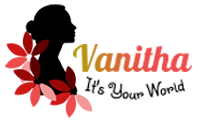
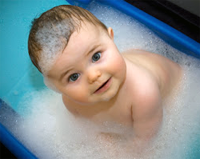
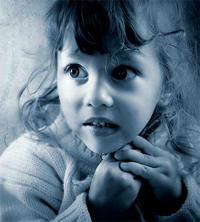





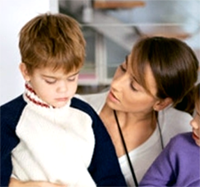
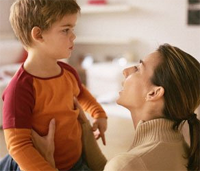
_గురిఅవుతున్న_విద్యార్ధులు_bullyong_2_large.png)

